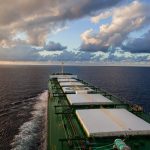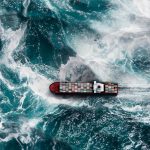Australian authorities say the newly acquired futuristic icebreaker RSV Nuyina suffered an electrical fault on its journey to its homeport of Hobart, Australia.
The Australian Antarctic Program (AAP) announced that the vessel, one of the world’s most advanced and capable icebreakers, suffered a fault in the electrical system that powers a propulsion motor on the port shaft line as it neared Hobart. “After assessing the issue, it was decided the ship could safely use the starboard propulsion system to enter port on Saturday morning, without needing an external tug to assist,” said AAP in a statement.
AAP added that while the repair of the electrical fault will be covered under warranty provisions in the contract, issues like this are not unexpected over the next two years as the process of commissioning the vessel and its systems occurs. “RSV Nuyina is designed to operate in the harsh and remote Antarctic environment and has a high level of redundancy across all its critical infrastructure systems,” it said.
The $500 million RSV Nuyina departed from the Damen Vlissingen shipyard in the Netherlands last month, undertaking an epic 13,000 nm journey over 47 days for docking at Hobart on Saturday. The 525-foot icebreaker will cost the Australian government’s $1.4 billion to build, maintain and operate over the next 30 years.
Australia contends the ship is a world-class base for Antarctic expeditions, a quantum leap forward for scientific research capacity, and a clear symbol of the country’s Antarctic ambition. The vessel can map the ocean floor to a depth of 36,000 feet, research polar weather patterns in the upper atmosphere and act as a floating laboratory to monitor the health of oceans and marine ecosystems. The ship is equipped with four permanent scientific laboratories and can accommodate an additional 20 containerized laboratories for specialized research projects that will evolve over the coming decades. It can accommodate 117 personnel and 32 crew for 92 days at sea.
RSV Nuyina is planning to embark on its first expedition voyage in December after a period of crew commissioning training and familiarization around the Tasmanian coast. The vessel will lead two other ships working to support research and resupply activities.
“We will have an ice-strengthened cargo vessel, Happy Dragon, and a second icebreaker, contract negotiations still underway, to ensure the major science projects for the summer season can be undertaken,” said Charlton Clark, Australian Antarctic Division Operations and Safety General Manager.
The design and build of the vessel has been a multinational effort involving the Australian Antarctic Division, the vessel operator Serco, Danish concept designers Knud E. Hansen, Damen’s engineering and detailed design teams in the Netherlands and the construction team at Damen Shipyards Galati in Romania.
Source: the Maritime Executive






